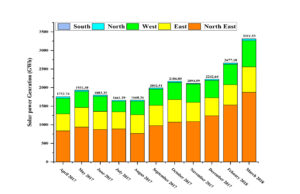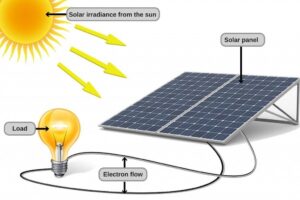
Abstract:
In the developing world different kinds of energy are in use, which are either renewable (solar, wind, hydroelectric power, biomass and geothermal energy) or non-renewable (fossil fuels, petroleum, nuclear and natural gas). Due to the limited resources of non-renewable energy and its scarcity in the near future, the world is shifting towards the use of renewable energy and its widely available resources. In which the solar energy is the only energy which can be used both at house hold and industrial level. Solar energy is the continuous release of heat and light from the Sun, which is due to the nuclear fusion reactions occurring on its surface. It is most advantageous energy source as it is universal, decentralized and non-polluting energy. However, areas where weather remains mostly cloudy and foggy will produce less electricity, which is the major disadvantage of this energy. Currently solar power in India is a fast-developing industry, as the country’s solar installed capacity reached 20 GW in February 2018. India expanded its solar-generation capacity 8 times from 2,650 MW on 26 May 2014 to over 20 GW as on 31 January 2018. Therefore, it will be the most widely used energy of the world replacing almost all non-renewable resources.
INTRODUCTION:
All life on the earth depends on solar energy; green plants make food by means of photosynthesis. Light is essential for this process to take place. Animal get their food from plants or by eating other animals that feed on plants. Plants and animals also need some heat to stay alive. Therefore, solar energy is a part of sustainable ecosystem. The solar energy that falls on India in one minute is enough to supply the energy needs to our country for one day. Man has made very little use of this enormous amount of solar energy that reaches the earth. In 2011, the International Energy Agency said that “the development of affordable, inexhaustible and clean solar energy technologies will have huge longer term benefits. It will increase countries’ energy security through reliance on an indigenous, inexhaustible and mostly import independent resource, enhance sustainability, reduce pollution, lower the costs of mitigating global warming, and keep fossil fuel prices lower than otherwise. Solar energy sometimes also called as radiant energy. The beam of radiation received from the sun on earth reflected in to space, another 15% is absorbed by the earth atmosphere and the rest is absorbed by the earth’s surface. This absorbed radiation consists of light and infrared radiation without it earth would be barren. It is an important source of renewable energy and its technologies are broadly characterized as either passive solar or active solar depending on how they capture and distribute solar energy or convert it in to solar power. Active solar techniques include the use of photovoltaic systems concentrated solar power and solar water heating to harness the energy. Passive solar techniques include orienting a building to the sun, selecting materials with favorable thermal mass or light dispersing properties, designing spaces that naturally circulate air.
Renewable energy is generated from renewable resources, which are naturally replenished on a human time scale, such as sun light, wind, rain, tides, waves and geothermal heat. Renewable energy often provides energy in four important areas i.e., electricity generation, air and water heating/ cooling transportation, and rural energy services. Based on REN 21’s Renewable Global Status Report (2017), renewable resources contributed 19.3% and 24.5% to human’s global energy consumption by generation of electricity in 2015 and 2016, respectively. These energy resources contribute majorly 8.9% from traditional biomass, 4.2% at heat energy modern biomass and geothermal. Renewable energy resources exist over wide geographical areas, in contrast to non-renewable energy sources, which are concentrated in a limited number of countries. In recent past, rapid deployment of renewable energy resulted in significant energy security, climate change mitigation and economic benefits. Thus, according to an international public opinion survey, there is strong support for promoting renewable sources such as solar power and wind power. In this respect, at least 30 nations around the world already have renewable energy contributing more than 20% of energy supply and the International renewable energy markets are projected to continue to grow strongly in the coming decade and beyond. In this direction, Iceland and Norway already generate all their electricity by using renewable energy sources and many other countries have set a goal to reach 100% of electricity generation by the use of renewable energy in the future. For example, Denmark Government decided to switch the total energy supply (electricity, mobility and heating/cooling) to 100% by the use of renewable energy by 2050. Worldwide investments in renewable technologies amounted to more than US$ 286 billion in 2015, in which countries like China, and the United States heavily invested in Wind, Hydro, Solar and bio-fuels. Globally there are an estimated 7.7 million jobs associated with the renewable energy industries, with solar photovoltaic being the largest renewable employer. As of 2015 worldwide more than half of all new electricity capacity installed was renewable. Apart from this to counter climate change and global warming concerns along with high oil prices, increasing government support and incentives increases the use of renewable energy for commercialization. It is also observed that greenhouse gas (GHG) emitters begin to be held liable for damages resulting from GHG emissions results in climate change, a high value for liability mitigation would provide powerful incentives for deployment of renewable energy technologies. According to a 2011 projection by the International Energy Agency, solar power generators may produce most of the world’s electricity within 50 years, reducing the emissions of greenhouse gases that harm the environment.
Application of Solar Energy:
There are following major application of solar energy:
(a) Solar Water Heating (b) Solar Heating of Buildings (c) Solar Distillation (d) Solar Pumping (e) Solar Drying of Agricultural and Animal Products (f) Solar Furnaces (g) Solar Cooking (h) Production of Power through Solar Ponds (i) Solar Green Houses.
(a). Solar Water Heating: A solar water heating unit comprises a blackened flat plate metal collector with associated metal tubing generally facing the direction of the Sun. The plate collector has a transparent glass cover above and a layer of thermal insulation beneath it.
(b). Solar Heating of Buildings: Solar energy can be used for space heating of buildings in many ways such as:
(i) Collecting the solar radiation by some element of the building itself i.e. solar energy is admitted directly into the building through large windows.
(ii) Using separate solar collectors which may heat either water or air or storage devices which can accumulate the collected solar energy for use at night and during rainy days.
(c) Solar distillation: In semi-arid or coastal areas there is scarcity of potable water. The abundant sunlight in these areas can be used for converting saline water into potable distilled water by the method of solar distillation.
(d) Solar-pumping: In solar pumping, the power generated by solar-energy is utilized for pumping water for irrigation purposes.
(e) Solar drying of agricultural and animal products: This is a traditional method of utilizing solar energy for drying of agricultural and animal products.
(f) Solar Furnaces: In a Solar furnace, high temperature is obtained by concentrating the solar radiations on to a specimen using a number of heliostats (turn-able mirrors) arranged on a sloping surface. The solar furnace is used for studying the proper ties of ceramics at extremely high temperatures above the range measurable in laboratories with flames and electric currents.
(g) Solar Cooking: A variety of fuel like coal, kerosene, cooking gas, firewood, dung cakes and agricultural wastes are used for cooking purposes. Due to the energy crisis, supply of these fuels are either deteriorating (wood, coal, kerosene, cooking gas) or are too precious to be wasted for cooking purposes (cow dung can be better used as manure for improving soil fertility). This necessitated the use of solar energy for cooking purposes and the development of solar cookers.
(h) Production of Power through Solar Ponds: A solar pond is a natural or artificial body of water utilized for collecting and absorbing solar radiation and storing it as heat. It is very shallow (5-10 cm deep) and has a radiation absorbing (black plastic) bottom. It has a curved fiber glass cover over it to permit the entry of solar radiation but reduces losses by radiation and convection (air movement). Loss of heat to the ground is minimized by providing a bed of insulating material under the pond. Solar ponds utilize water for collecting and storing the solar energy which is used for many applications such as space heating, industrial process heating and to generate electricity by driving a turbine powered by evaporating an organic fluid with a low boiling point.
(i) Solar Green Houses: A green house is a structure covered with transparent material (glass or plastic) that acts as a solar collector and utilizes solar radiant energy to grow plants. It has heating, cooling and ventilating devices for controlling the temperature inside the green house.
Forms in which we use solar energy:
We all have been using sun’s energy since beginning of the life on Earth for numerous purposes but recently we have started using this energy for generating electricity. About 70% of the light that hit the earth gets reflected back to space and only the remaining 30% light is enough to meet up our needs for years to come. The energy that is absorbed by the earth is used for drying clothes, heating up homes, used by plants in the process of photosynthesis and taken in by the ocean where the heat creates wind and heat currents. When we get the solar energy from the sun it gets trapped and stored and can be used in various ways to generate power. Solar energy can be used as direct or indirect, active or passive. Basically, there are two ways in which we can harness sun’s energy:
- Solar Thermal: Solar thermal is also known as solar water heater. In this system, solar energy is used directly to generate heat. Solar panels are used to trap the heat from the sun and are used to heat water in the glass panels.
- Photovoltaic cells: This method converts the sun’s energy into electricity. Photovoltaic cells are most popular form of converting solar energy into electricity. These cells are silicon-based pieces of materials that absorb the sun’s light. When the sunlight enters the cells, it causes the electrons to move. These electrons move in a certain direction which is known as current. This electricity is in the form of direct current.
Advantages and Disadvantages of Solar Energy
There are several advantages and disadvantages of solar energy, which are listed below. But in the near future some of the disadvantages may be overcome.
Advantages of Solar Energy:
- Solar energy is kind of universal, decentralized and non-polluting energy.
- Solar energy helps considerably in maintaining the ecological balance through the process of photosynthesis and greenhouse effect.
- Solar energy is bound to achieve great economic importance in future because of depletion trend of convention energy sources.
Disadvantages of Solar Energy:
- The initial cost of purchasing and installing solar panels always become the first disadvantage. To overcome this disadvantage, subsidy programs, tax initiatives and rebate incentives are given by government to promote the use of solar panels. As new technologies emerge, the cost of solar panels is likely to decrease along with increasing its efficiency and then we can see an increase in the use of solar cells to generate electricity.
- Areas which remain mostly cloudy and foggy will produce electricity but at a reduced rate and may require more panels to generate enough electricity for home. Houses which are covered by trees, landscapes or other buildings may not be suitable enough to produce solar power.
- Most of the photovoltaic panels are made up of silicon and other toxic metals like mercury, lead and cadmium that cause environmental pollution in the atmosphere.
Examples for Use of Solar power on large scale in the world:
- Longyangxia Dam Solar Park (850MW, China): The Longyangxia Dam Solar Park is China’s latest in a long line of large-scale solar energy projects. A solar farm in the city of Cixi in Eastern Zhejiang province installed 300 hectares of solar panels above a fish farm. The farm is expected to generate 220GW hours of electricity in a year, which is enough for 100,000 households according to the state-run Xinhua news agency of China.
- Datong Solar Power Top Runner Base (1000 MW, China): Datong Solar Power plant in China has the potential to be the largest solar plant in the world. According to government statistics, from July 2016 to January 2017, Datong generated a total of 870 million watts of electricity, equivalent to more than 120 million watts per month of power generation.
- Arnedo Solar Plant, Spain: This facility sits on seventy hectares and houses 172,000 panels, which produces about 34 GW electricity every year, and powers 12,000 households, preventing the generation of 375,000 tones CO2.
- Waldpolenz Solar Park, Germany: Walpolean Solar Park, which is the world’s largest thin film photovoltaic (PV) power system, is built in on military air base to the east of Leipzig in Germany. The power plant is a 40-megawatt solar power system using thin film technology.
- Topaz Solar Farm, USA: Topaz Solar Farm is a proposed 550 (MW) solar photovoltaic power plant, to be built by First Solar, (thin film silicon solar module maker) in the Carrizo Plain, northwest of California Valley.
Examples for Use of Solar power on large scale in India:
Solar power in India is a fast-developing industry. The country’s solar installed capacity reached 20 GW in February 2018 (Fig. 1 & 2). India expanded its solar-generation capacity 8 times from 2,650 MW on 26 May 2014 to over 20 GW as on 31 January 2018. The 20 GW capacities were initially targeted for 2022 but the government achieved the target four years ahead of schedule. The country added 3 GW of solar capacity in 2015-2016, 5 GW in 2016-2017 and over 10 GW in 2017-2018, with the average current price of solar electricity dropping to 18% below the average price of its coal-fired counterpart.
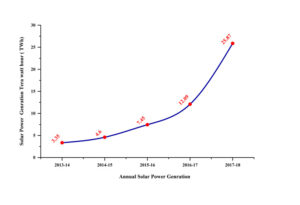 Fig. 1: Increasing trend of solar power generation in India from 2013-18
Fig. 1: Increasing trend of solar power generation in India from 2013-18
Fig. 2: Zone wise solar power generation in India during 2017-18
In January 2015 the Indian Govt expanded its solar plans, targeting US$100 billion in investment and 100 GW of solar capacity (including 40 GW from roof top solar) by 2022. India’s initiative of 100 GW of solar energy by 2022 is an ambitious target, since the world’s installed solar power capacity in 2017 is expected to be 303 GW. The improvements in solar thermal storage power technology in recent years has made this task achievable as the cheaper solar power need not depend on costly and polluting coal/gas/nuclear based power generation for ensuring stable grid operation. A report published by the Institute for Energy Economics and Financial Analysis (IEEFA) found that India installed 10 GW of solar in 2017; almost double its record in 2016 (Table 1). Crucially, India’s “Scheme for Development of Solar Parks” has proven successful at attracting foreign capital toward construction of the world’s largest ultra-mega solar parks.
Table 1: Trends of solar power generation in India
| Years Annual solar power generation | Solar power generation, Terawatt hour (TWh) |
| 2013-14 | 3.35 |
| 2014-15 | 4.60 |
| 2015-16 | 7.45 |
| 2016-17 | 12.09 |
| 2017-18 | 25.87 |
Table 2: Monthly solar power generation in India from April 2017 to March 2018
| Month | Regional solar power generation (GWh) | Total (GWh) | ||||
| North | West | South | East | North east | ||
| April 2017 | 458.76 | 419.26 | 833.47 | 40.16 | 0.99 | 1,752.74 |
| May 2017 | 528.92 | 426.05 | 935.51 | 39.72 | 1.17 | 1,931.30 |
| June2017 | 489.02 | 399.95 | 871.08 | 36.36 | 0.92 | 1,803.35 |
| July2017 | 461.40 | 282.92 | 886.69 | 27.17 | 0.98 | 1,661.29 |
| August2017 | 504.42 | 363.99 | 765.21 | 30.43 | 1.17 | 1,660.26 |
| September 2017 | 547.08 | 438.70 | 974.52 | 32.84 | 0.94 | 2,002.51 |
| October 2017 | 608.61 | 456.16 | 1,069.60 | 33.31 | 1.11 | 2,186.00 |
| November 2017 | 518.77 | 489.30 | 1,083.92 | 19.27 | 1.32 | 2,094.59 |
| December 2017 | 483.35 | 465.63 | 1242.36 | 31.49 | 1.32 | 2,242.64 |
| January 2018 | – | – | – | – | – | 2,547.77 |
| February 2018 | 548.61 | 546.80 | 1,530.38 | 35.23 | 0.98 | 2,677.10 |
| March 2018 | 685.27 | 703.39 | 1,872.31 | 49.26 | 1.29 | 3,311.53 |
| Total (GWh) | – | – | – | – | – | 25,871.08 |
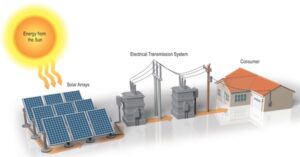
Success stories of achievements in India:
India’s Cochin Airport: World’s First 100% Solar Powered Airport: The world is developing at a faster pace than ever before; the scientific and technological development we have seen in the last few decades alone is unprecedented by anything we have previously experienced. However, the human thirst for rapid development has come at a significant compromisation to our environment. Climate change and global warming have currently become the most important challenges of the world. Carbon dioxide emission is one of the major factors responsible for global warming, and the combustion of fossil fuels for our energy needs is the major source of these dangerous emissions. To overcome these challenges the Govt of India has set an example by taking a major step towards greener and cleaner energy by developing the world’s first airport to be run completely on solar energy. Cochin airport, India’s fourth-largest international airport, has become the first airport to function completely on solar energy, marking a major milestone in our planet. This airport requires about 48,000 units of electricity per day based upon the passenger’s traffic. On August 2018, Cochin International Airport Limited (CIAL) announced that the airport will run completely on solar power, making it the first airport in the world to do so. This will make the airport “absolutely power neutral”- which means that it can create as much energy as it consumes.
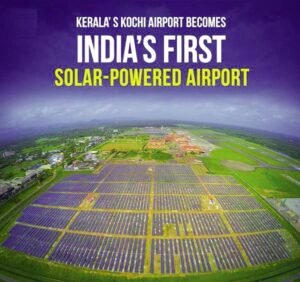
Kamuthi Solar Plant
India built the world’s largest solar plant in record time by inaugurating world’s largest solar power plant expending in 10 km sq at Kamuthi, Tamil Nadu. It produces 648 megawatts of power, nearly 100 MW more than California’s Topaz Solar Farm, which was previously the largest solar plant at a single location. At full capacity, the Kamuthi plant can provide enough electricity to power around 150,000 homes.
Dhirubhai Ambani Solar Park: The Dhirubhai Ambani Solar Park at Dhursar village near Pokhran in the Jaisalmer, Rajasthan is a 40 MW photovoltaic power station, commissioned in 2012. It is one of a large number of solar parks expected in a 35,000 km2 area of the Thar desert that has been reserved for solar power Projects. The solar park was constructed using 500,000 cadmium telluride photovoltaic’s (CdTe) modules by First Solar.
Kurnool Ultra Mega Solar Park: Kurnool Ultra Mega Solar Park is a solar park spread over a total area of 5,932.32 acres in Panyam Mandal, Kurnool, Andhra Pradesh with a capacity of 1,000 MW. The park utilizes over 4 million solar panels with capacities of 315 and 320 Watts.
Pavagada Solar Park: Karnataka is the top solar state in India exceeding 5,000 MW installed capacity by the end of financial year 2017-18. The installed capacity of Pavagada Solar Park is 600 MW and its capacity reached to 2,000 MW by the end of year 2020.
Kannauj home to UP’s first 100% solar powered villages: A fully funded initiative of the state government of Uttar Pradesh in 2015 for remote villages of Kannauj have solar energy in 450 homes, streets, flour mills to submersible water pumps. This has changed the life of 2,000 odd residents of Chanduhar and Fakirpur villages of Kannauj.
Conclusion:
India has always faced a shortage of energy despite being one of the largest producers of electricity in the world. There will be an increase in electricity demands with the increasing population. Solar energy development in India can be an important tool for solving power problems in underdeveloped regions and facilitating regional economic development. Many states of India have great potential for developing solar power systems that can provide secure electricity supply to domestic, commercial, and industrial sectors. The socio-economic benefits of using solar energy can be observed in areas where people put hard labour into the collection of fuel for cooking. The availability of electricity in remote areas allows people to utilize its benefits to improve their standard of living and create economic opportunities. But still today more than 300 million people in India are living without electricity. Let us hope that more and more villages follow the examples set by different villages where 100% of electricity is produced from solar energy with the proper help and support from the state governments, NGOs and power corporations.
Pragya Sharma1, Apoorv Gupta2, Ravi Kumar Tiwari1, Seema Mishra2
and Sanjay Dwivedi1*
1Plant Ecology and Climate Change Science Division,
CSIR-National Botanical Research Institute, Lucknow-226001, India
2Department of Chemistry, University of Lucknow, Lucknow-226007, India


